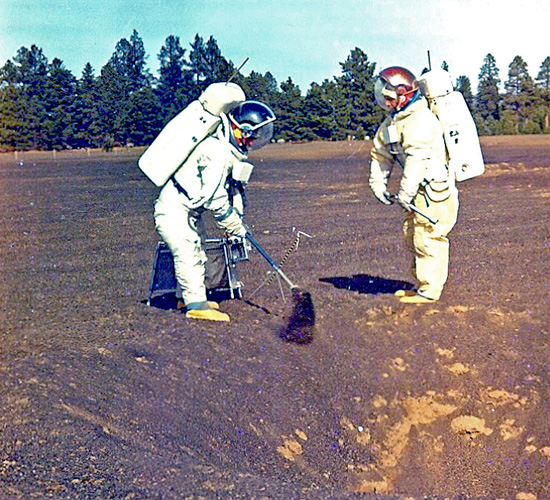|
|
|
|---|
Tuesday, September 11, 2007

A few years before the first landing of an Apollo crew on the moon, scientists recontoured a volcanic field just outside of Flagstaff, Arizona, with artificial impact craters resembling those found on Mare Tranquillitatis, the proposed first manned American landing site.
With high explosives, they terraformed a lunar surrogate right here on the surface of the earth.
There, during the 60s and 70s, nearly all of the Apollo astronauts who walked on the moon were taught the basics in extraterrestrial exploration and earthworks. They learned how to make field observations, how to make maps, and how to properly collect lunar samples. It is there as well that the tools with which human beings would physically deform another world for the first time were tried out.
Hammers, adjustable sampling scoops, rakes and tongs, rock drills and rover vehicles. Together with astronaut boots and gloves, these would soon leave an imprint, albeit minimal, where before meteors and the solar wind held a monopoly in lunar resurfacing.

If we can digress here briefly, it would be to ask whether these simulated landing sites — where the earth is turned and upturned, displaced and scarred — are a kind of Japanese rock gardens.
Because are not the tracings of human activity highly considered gestures, laden with abstract notions and cultural baggage?
Are not these scoured terrains imprinted with a complex, messy network of interrelated cultural, political, technological, philosophical and even metaphysical concerns that are worth contemplating? A field turned into a text which, if it cannot be understood through the writings of a revered Buddhist monk, can perhaps be deciphered through the Cold War speeches of John F. Kennedy.
Did the astronauts not use a rake?

To return back to Crater Field, as the Arizona training site is called, one wonders whether there are other simulated moons out there, or in the drawing boards now that plans are underway for an American return mission.
And is there a surrogate Mars, wherein a duplicate Opportunity tested entry descent scenarios into a duplicate Victoria Crater?
A Titan facsimile?
An analogue for Venus?
Two things seem worth mentioning right about now.
Firstly, a post at Wired Science last month told us that a group of nine intrepid scientists and engineers spent four months cooped up together in a remote simulated Martian habitat.
Their space habitat (the size and shape of an expected martian abode) is located near a crater on Devon Island above the Arctic Circle in Canada. The simulation is an experiment in planetary exploration and its demands. The team was looking at what happens to a crew in a remote, harsh, close-quartered environment under simulated Martian conditions (crews would only go outside the habitat during a fully simulated EVA) when they are working on real science.
Secondly, from an article in Reuters, we learned that “scientists are using the pine-forested slopes of a Mexican volcano as a test bed to see if trees could grow on a heated-up Mars.” At an elevation of 13,780 feet, planetary scientists from NASA and Mexican universities are investigating “what makes trees refuse to grow above a certain point, where temperatures drop and the air becomes thinner, to see how easily they could grow on Mars.”

But one last thing: are there others?
Please let us know.
“Ground truth”: or, Wanted: Fake Moon Dirt
Labels: testing_grounds